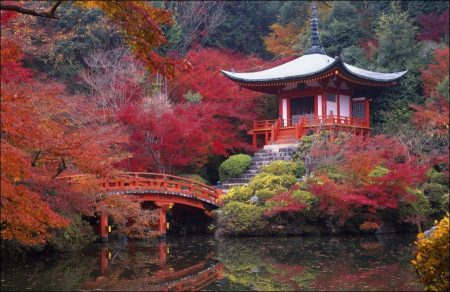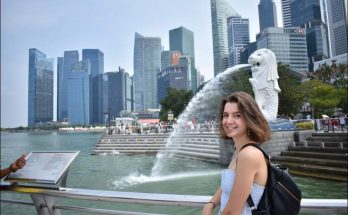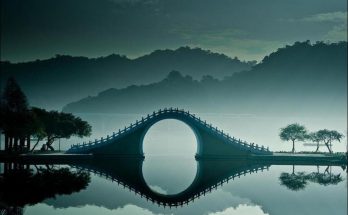Making the round of these “detached palaces,” we recall the fact which is too often overlooked, namely, that the beauties of Kyoto are not confined within the limits of the city. Indeed, a considerable proportion of the so-called sights of Kyoto are on the outskirts, and these have a special lure in summer, when Kyoto is at the greatest discount because of the mountains screening it from the wind. It is then that the hearts of both visitors and Kyoto folks yearn after boating on the Uji, shooting the Hozu Rapids, or walks up Arashiyama and the priest-ridden Hieizan.
Uji has three boasts to make, which are, or ought to be, world-famous; its Byōdōin temple with its phoenix hall, its tea plantations, and its cormorantfishing. The wonderful “phoenix hall,” consisting of three buildings connected by corridors, was built in 1054 in the shape of the sacred bird descending to earth with its outspread wings.
The golden Amida enshrined in the central hall is surrounded with marvelous decorations of religious motives which, though they are much the worse for time and weather, are none the less wonderful. The cormorant fishing on the Uji is growing as famous as that on the Nagara; and if the season favors us, we must not go without a sight of the tea plantations, Uji being a classic name for tea.
The town of Ōtsu with its famous Biwako, as large as the lake of Geneva, lies within less than half an hour’s ride by motor. A big European-style hotel is being built on the bank of the lake within easy reach of the so-called “Eight Classic Sights of Ōmi.” The whole district teems in memories and relies of the Heian period, of which one of the most interesting, to lovers of literature, is Ishiyama-dera (rock-hilltemple)–one of the eight Ōmi views referred to -especially that room of the temple in which Lady Murasaki ( 9 75)- 1031) wrote her celebrated Tales of Genji, the greatest romance ever produced in Japan. Lake Biwa and its environs, especially the Miidera temples, are worth more than a passing glance, and these excursions may be made from your headquarters in Kyoto, if you so desire.
Among other attractions of Kyoto suburbs, we may mention the Hachiman temple on Otokoyama, lying a little off the middle of the shining motor road between Kyoto and Osaka. It is sacred to the god of war, Hachiman, dedicated to Ōjin Tenno, Empress Jingū and Hime Ōkami. Many of its edifices are “national treasures.” This temple was personally visited by Emperors in the past, especially in time of war or national distress, on more than 70 occasions, the last august visit being made by Meiji Tenno in 1877.
In our day the Emperor makes it a rule to send special messengers on its regular memorial days. Once it was a laborious climb, especially for women, but now it is made perhaps too accessible by the cable-car which carries one to the top of the hill in a very short time. An exotic touch (in the Japanese eye) is given to the scene by a modern marble memorial erected in the spring of 1934 to the memory of Thomas Alva Edison.
The Japanese inscription carved in relief states that it was the bamboo discovered in the wood of the temple precincts that was used for the filament of the first incandescent lamp invented by Mr. Edison. Some grumbling was heard when it was proposed to erect this memorial, but the true Kyoto spirit which ever worships art and beauty, triumphed at last and consented to give a portion of this sacred region to the memory of a great foreigner.
Visits: 97



